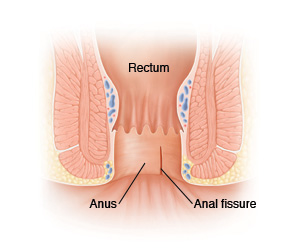The anal canal is the end part of the intestinal tract. It includes the rectum and anus. Stool is passed through the anus. Sometimes a crack or tear occurs in the lining of the anal canal. This condition is called an anal fissure. A fissure is one of the many conditions that can happen in the anal area. It can be confused with hemorrhoids. Your health care provider can do an exam to diagnose your child's condition.
Anal fissures are caused by injury or stretching of the anal canal. This is most often due to having hard, difficult-to-pass stools (constipation). Severe diarrhea or placing an object into the anal canal may also cause a fissure. Less often, other conditions, such as an inflammatory bowel disease like Crohn's disease, can cause fissures.
Symptoms include pain and bleeding, especially during a bowel movement.
-
There may be bright red blood on the outside of the stool or on the toilet paper (or baby wipe) after a bowel movement.
-
Sometimes there is swelling, itching, and skin irritation.
-
The area may spasm, causing more pain and skin separation.
An anal fissure often heals on its own with no special treatment. You can follow home care directions to help prevent constipation and ease symptoms. Once the area has healed, follow-up tests may be needed.
In some cases, a fissure doesn't heal on its own. Surgery may then be needed to close the tear.
Home care
Medicines
Your child may be prescribed medicines, such as topical creams, pain relievers, stool softeners, or laxatives. Follow all the directions when giving any of these medicines to your child.
Don't give your child over-the-counter medicines without talking with the health care provider first. Other medicines may be prescribed if needed. Tell your health care provider if your child is taking any other medicines.
In rare cases, other treatments for related health conditions may be needed.
General care
-
To help ease constipation, you may be asked to:
-
Add more fiber in your child’s diet. This includes foods such as whole grains, fresh fruits, and vegetables. Fiber adds bulk to stool and absorbs water to soften stool. This helps stool pass through the colon more easily. If needed, a fiber supplement may also be prescribed.
-
Encourage your child to drink lots of water. This can also help soften stool.
-
Limit fast foods and junk foods that are usually high in fats and sugars.
-
-
To help ease pain and relax the muscles in the anus, have your child soak in a bath with a few inches of warm water. This is called a sitz bath. Your child can do this for 10 to 15 minutes at a time, a few times a day (especially after bowel movements) or as advised. These baths help soothe and relax the anal muscles. This helps the healing process. Do NOT use any soap on the irritated area.
-
Keep a careful record of when your child has a bowel movement and the type of stool that was passed. This may help the health care provider decide on care for your child. Older children can be encouraged to keep their own records.
-
Check your child’s anus for bleeding or signs of infection. Older children may be asked to watch their own symptoms.
-
Help your child to maintain a routine bowel habit.
Follow-up care
As your child's symptoms improve, your child may still remember and anticipate the pain for a while. So do NOT stop your child's medicines all of a sudden. Discuss with your health care provider how to have your child gradually stop taking the medicines. Follow up with your child’s health care provider, or do as advised. If testing was done, you’ll be told the results and any new findings that may affect your child’s care. It's important to continue to treat constipation or the fissure may come back.
When to get medical advice
Unless your child’s health care provider advises otherwise, call the provider right away if:
-
Your child's symptoms get worse, or they don’t get better with home care.
-
Your child has signs of infection, such as increased redness, swelling, or foul-smelling drainage in the area around the fissure.
-
Your child has ongoing constipation or explosive diarrhea.
Featured in


